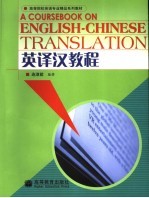图书介绍
英译汉教程2025|PDF|Epub|mobi|kindle电子书版本百度云盘下载

- 连淑能编著 著
- 出版社: 北京:高等教育出版社
- ISBN:7040189380
- 出版时间:2006
- 标注页数:367页
- 文件大小:22MB
- 文件页数:383页
- 主题词:
PDF下载
下载说明
英译汉教程PDF格式电子书版下载
下载的文件为RAR压缩包。需要使用解压软件进行解压得到PDF格式图书。建议使用BT下载工具Free Download Manager进行下载,简称FDM(免费,没有广告,支持多平台)。本站资源全部打包为BT种子。所以需要使用专业的BT下载软件进行下载。如BitComet qBittorrent uTorrent等BT下载工具。迅雷目前由于本站不是热门资源。不推荐使用!后期资源热门了。安装了迅雷也可以迅雷进行下载!
(文件页数 要大于 标注页数,上中下等多册电子书除外)
注意:本站所有压缩包均有解压码: 点击下载压缩包解压工具
图书目录
Chapter 1 General Principles1
1.1 What is Translation?1
1.1.1 Linguistic Views on Translation1
1.1.2 Cultural Views on Translation1
1.1.3 Literary Views on Translation2
1.1.4 Semantic Views on Translation2
1.1.5 Functional Views on Translation3
1.1.6 Communicative Views on Translation3
1.2 The Assessment of Translation3
1.2.1 Translation Criteria Put Forward by Famous Translators or Translation Theorists3
1.2.2 Other Factors Affecting the Evaluation of Translation6
1.2.3 Criteria for Beginners of Translation7
1.2.4 Translation Proficiency:the Requirements of the Teaching Syllabus for the English Major(中国高等学校英语专业英语教学大纲对翻译教学的要求)7
1.3 The Competence of a Translator8
1.3.1 Excellent Command of the Two Languages8
1.3.2 Considerable Knowledge of the Two Cultures9
1.3.3 Adequate Knowledge of the Subject Matter11
1.3.4 Fair Capacity for Writing11
1.3.5 Plenty of Practice and Adequate Knowledge of Translation Theories and Skills11
1.3.6 Skills in the Use of Information Technology12
1.4 Translation Strategies12
1.4.1 Literal Translation and Free Translation12
1.4.2 Foreignizing Translation and Domesticating Translation13
1.4.3 Style and Translation15
1.5 Basic Processes in Translating19
1.5.1 The Four-phase Process in Translating19
1.5.2 Some Dos and Don'ts for Students21
1.5.3 Procedures of Translation by a Team21
Chapter 2 Contrastive Studies of English and Chinese25
2.1 Studies of the English Language25
2.1.1 External History:Historical Information Related to the English Language25
2.1.2 Internal History:a Linguistic Review28
2.1.3 Some Characteristics of English29
2.2 Studies of the Chinese Language31
2.2.1 Some Major Factors Affecting the Chinese Language31
2.2.2 Some Characteristics of Modern Chinese32
2.3 English vs.Chinese:Ten Pairs of Features38
2.3.1 Synthetic vs.Analytic(综合语与分析语)38
2.3.2 Rigid vs.Supple(刚性与柔性)44
2.3.3 Hypotactic vs.Paratactic(形合与意合)47
2.3.4 Complex vs.Simplex(繁复与简短)49
2.3.5 Impersonal vs.Personal(物称与人称)50
2.3.6 Passive vs.Active(被动与主动)52
2.3.7 Static vs.Dynamic(静态与动态)54
2.3.8 Abstract vs.Concrete(抽象与具体)55
2.3.9 Indirect vs.Direct(间接与直接)56
2.3.10 Substitutive vs.Repetitive(替换与重复)59
Conclusion66
3.1 Choice of Affective Meanings67
Chapter 3 Diction(选词法)67
3.2 Choice of Grammatical Meanings70
3.3 Choice of Contextual Meanings71
3.4 Choice of Collocative Meanings72
3.5 Choice of Stylistic Meanings74
3.6 Choice of Ambiguous Meanings81
3.7 Choice of Extended Meanings83
3.8 Choice of Equivalent Meanings87
3.9 Choice of Exact Meanings92
3.10 Choice of Different Chinese Words to Translate the Same English Word or Use of the Same Chinese Word(s)to Translate Different English Words95
Conclusion102
Chapter 4 Conversion(转换法)103
4.1 Conversion of Word Classes103
4.2 Conversion of Sentence Members114
4.3 Conversion of Impersonal Subjects118
4.4 Conversion of Perspectives125
Conclusion128
5.1 Structural Addition129
Chapter 5 Addition(增补法)129
5.2 Semantic Addition130
5.3 Rhetorical Addition140
Conclusion144
Chapter 6 Omission(省略法)146
6.1 Omission of Words Peculiar to English146
6.2 Omission of Words Superfluous in Chinese149
Conclusion162
Chapter 7 Repetition(重复法)164
7.1 Grammatical Repetition165
7.2 Rhetorical Reduplication and Repetition170
Conclusion183
Chapter 8 Inversion(倒置法)184
8.1 Inversion of Word Order in Translating Word-Groups or Phrases184
8.2 Inversion of Word Order in Translating Attributes185
8.3 Position of Adjective Clauses188
8.4 Inversion of Adverbials193
8.5 Position of Adverbial Clauses194
8.6 Inversion of Sentence Structure196
Conclusion205
Chapter 9 Negation(反译法)208
9.1 Transfer of the Negative208
9.2 Conversion of the Affirmative into the Negative211
9.3 Conversion of the Negative into the Affirmative213
9.4 Translation of English Questions and Answers216
9.5 Translation of Various Kinds of Negations220
Conclusion251
Chapter 10 Division(拆译法)252
10.1 Picking Out of Words252
10.2 Picking Out of Phrases254
10.3 Splitting of Complex Sentences256
10.4 Splitting of the Whole Sentence262
Conclusion268
11.1 Condensation of Phrases and Clauses270
Chapter 11 Condensation(缩译法)270
11.2 Condensation of Complex Sentences into Simple Sentences271
11.3 Condensation of Compound Sentences into Simple Sentences273
11.4 Condensation of Two or More Simple Sentences into One Simple Sentence273
Conclusion276
Chapter 12 Translation of the Passive(被动式译法)277
12.1 Features of the English Passive277
12.2 Features of the Chinese Passive279
12.3 Common Ways to Translate the English Passive282
Conclusion289
Chapter 13 Translation of Long Sentences(长句译法)290
13.1 Features of Long English Sentences290
13.2 Features of Chinese Equivalents to Long English Sentences291
13.3 Common Ways to Translate Long Sentences292
Conclusion311
Chapter 14 Translation of Culture-loaded Expressions(文化词语译法)313
14.1 Foreignizing Translation313
14.2 Domesticating Translation317
14.3 Semantic Translation320
14.4 Three Don'ts in Translating English Idioms322
14.5 Proper Use of Chinese Idioms in Translation330
Conclusion343
Chapter 15 Translation of Proper Nouns and Technical Terms(专有名词和专门术语译法)344
15.1 Transliteration344
15.2 Semantic Translation349
15.3 Both Transliteration and Semantic Translation350
15.4 Shape-related Symbol Translation with a Semantic Explanation Added at the End351
15.5 Semantic Translation with the Original Alphabet,Abbreviation or Number at the Beginning or at the End351
15.6 Borrowing of the Original Abbreviation351
15.7 Coinage of New Characters352
Conclusion357
Appendix Table on English-Chinese Transliteration(英汉译音表)359
References360
Further Reading362